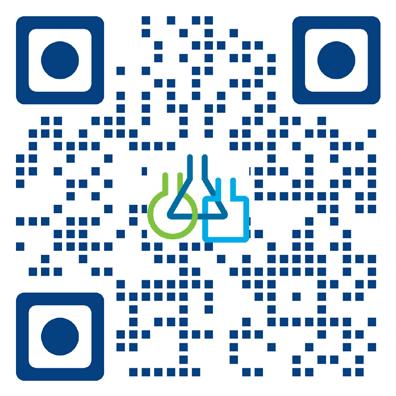2023
NF CONFERENCE HIGHLIGHTS:

NF CONFERENCE HIGHLIGHTS:
Investing in Research
Empowering the Community
Accelerating Treatments
Strengthening Clinical Trials

With tremendous enthusiasm, we have summarized the most important highlights from the research presented at the Children’s Tumor Foundation (CTF) 2023 NF Conference in June 2023. The NF Conference is the most important gathering of the NF research and clinical communities, focused on improving outcomes for patients with neurofibromatosis type 1 (NF1) and all types of schwannomatosis (SWN), including NF2-related schwannomatosis (NF2-SWN).
Our dedicated NF Conference Chairs included Piotr Topilko, PhD from INSERM, France; Verena Staedtke, MD, PhD, from Johns Hopkins University; and Cristina Fernandez-Valle, PhD, from the University of Central Florida. Alongside CTF’s dedicated science team staff, they planned an exciting agenda that aligned with the ambitious CTF strategic plan.
The visionary Frank McCormick, PhD, FRSC, from the University of California San Francisco, and the director of the National Cancer Institute RAS Initiative in Frederick, Maryland, opened the Conference highlighting innovative treatment opportunities for NF from a mechanistic point of view.
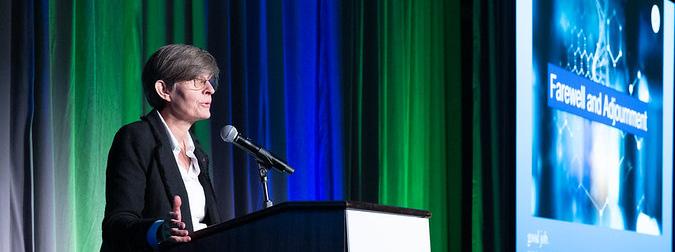
With the strategic aim to expand the NF research field, we invited keynote speakers from outside the realm of NF. Ross Cagan, PhD, from the University of Glasgow, and Ivana Trapani, MD, PhD, from Telethon Institute of Gen and Medicine, Naples, shared their unique approaches to the diseases they are working on. Michelle Monje, MD, PhD, from Stanford University, gave an interesting perspective on how neurons can contribute to the development and growth of NF1-related tumors.
Thanks to new FDA guidelines, clinicians and researchers are allowed, under very specific circumstances, to select clinical treatments using New Alternative Methodologies, instead of the traditionally used animal models. That is why Min Jae (MJ) Song, Senior Scientist at the NIH’s National Center for Advancing Translational Sciences (NCATS) spoke about Novel Alternative Models (NAMs), being developed at
In addition to the very inspiring keynotes, you will appreciate an excellent comprehensive report tackling the outstanding research (funded by CTF and our partner funders) from bench to bedside, and all the new methods and systems that are being developed to accelerate access to clinical treatments.
You will be able to enjoy our progress in advancing clinical trials, from the fantastic CDMRP-funded clinical trials consortium to the NTAP-funded cutaneous NF study to the CTF co-funded platform trial for NF2-SWN. We have brought in many new companies from the US to the UK, Japan to South Korea: the world cares about ending NF!
Last but not least, we recognized and inspired the community, with the recognition of scientific excellence in Dr. Margaret (Peggy) Wallace as our von Recklinghausen awardee, and empowered and educated the community with an excellent Patient Engagement session.
Laser-focused on getting the best possible treatments to you and your loved ones, I am sure you can appreciate that we touch all pillars of our strategic plan: Invest in Research, Accelerate Treatments, Strengthen Clinical Trials, and Educate/Empower the community.
I hope you are as inspired as I am as you read this summary. The NF Conference is a testament to what we can accomplish when sharing knowledge and fostering collaboration. Our impact shows in the remarkable advancements in care and treatments as we grow ever closer to ending NF.
Annette Bakker, PhD, President Children’s Tumor FoundationIn drug development, preclinical studies begin prior to clinical trials and are aimed at collecting important information about the nature and safety of drug treatments, how the treatments affect the body, and their therapeutic potential. The data is generally brought together using specific animal models or cell culture systems that are relevant to the disease of interest and are considered to be “predictive” of how the drug will impact humans. One main concern over the last decade in preclinical testing is the lack of clinical translation. This means that although drug treatments seem to work well in the preclinical setting and strong supportive data is generated in rodents and cells, these treatments when administered to patients during clinical testing, are not effective. This is a very costly and time-consuming problem that is especially detrimental in rare conditions such as neurofibromatosis and schwannomatosis, where both factors are of utter importance.
During 2023 NF Conference, it was wonderful to see so much emphasis on translating preclinical research to patients and learn of the newer and very relevant models in the NF field. Recently the Food and Drug Association (FDA) has been pushing towards novel alternative models (NAMs) in order to improve predictability and reduce dependence on animal studies (Read more here). This effort was reflected during the NF Conference as new 2D and 3D cell models took center stage. A few identified hot topics in preclinical research are covered below and include precision medicine models, patient-derived organelle models, human inducible pluripotent stem cells (iPSCs), and a more rigorous design of preclinical trial-like studies.

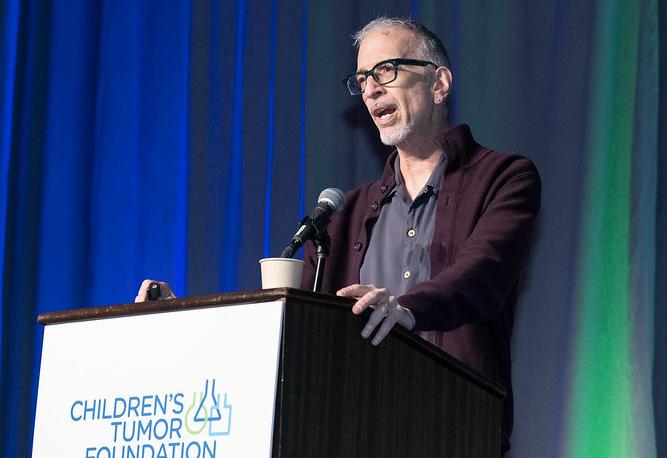
In his “fly to bedside” approach, Ross Cagan, PhD, from the University of Glasgow, presented his work in precision medicine by creating patient mutation avatars. Although Dr. Cagan’s work is mostly based on cancer biology, such an approach could expand to other tumor types, such as those found in NF patients. Dr. Cagan’s approach is
based on the idea that patients are all heterogeneous, and different genetic variants make tumors unique and lead to varied treatment responses. In order to personalize treatments and enhance the treatment response, a patient tumor sample is sequenced and analyzed. This information is then used to re-create a similar set of genetic variants in a fly model (Drosophila). The fly model can then be used to screen a large panel of FDA-approved drugs or a combination of drugs to identify the most efficacious treatment for that unique patient. Dr. Cagan presented some exciting data using this approach in adenoid cystic
carcinoma (a rare cancer), where a novel 3-drug cocktail led to tumor stability. These findings bring some new light in precision medicine and an interesting new path forward for NF-related tumors.
A similar precision medicine approach was also discussed by Robert Kesterson, PhD, from Pennington Biomedical Research Center at Louisiana State University. Dr. Kesterson’s lab has focused on understanding the disease mechanisms associated with NF1, and they have created several mouse avatars harboring the genetic variants found in patients. Similar to the fly platform, these “humanized” mouse models can be used to understand disease biology

as it relates to individual patients. They are also critical for drug testing in order to identify treatments with optimal efficacy for the specific pathogenic variants found in NF1 patients. It is important to also point out that patientspecific models are especially important in testing various gene therapy approaches (see Gene Therapy, pg. 7).
With the new push toward NAMs (novel alternative models), several new in vitro (in a dish) models were presented at the meeting. Former CTF Young Investigator Awardee, Liyam Laraba, PhD, from the University of Plymouth shared his work on primary 2D cultures of meningioma and schwannoma tumors derived from patients. For his research, patient tumors are extracted, and cells are harvested and cultured in a dish. This system is especially important in identifying novel disease targets and targeted therapies for NF2-related tumors. Moreover, these cultured cells can also be implanted into a mouse and allowed to grow to resemble a patient tumor which is an outstanding way of translating in vitro studies to an in vivo environment (in a living organism).
A major translational gap in research is seen between in vitro (in a dish) and in vivo (in a living organism) studies. One attempt at filling this gap is by using a 3D spheroid model system, which is a three-dimensional cell culture that arranges into a sphere-like formation as cells reproduce. One of these models was very elegantly presented by Laurien Van De Weijer, MSc, also from the University of Plymouth. Laurien’s research focuses on a patient-derived 3D model of a meningioma tumor. A 3D spheroid model such as this can be used to better demonstrate how cells interact in a more natural tumor environment and increase the accuracy with which compounds progress from an in vitro to in vivo system during screening. This 3D spheroid system was shown to be similar to human patients under a microscope and maintained the same genomic alterations found in patients. It also demonstrated characteristics of a process called epithelial-mesenchymal transition, or EMT, which occurs in humans. Most importantly, this system was shown to be more sensitive compared to a 2D system
(which is only a single layer of cells) when screening drug compounds for efficacy. Laurien showed some impressive positive results using the 3D model to screen UNC2025, a compound targeting the MERTK signaling pathway, which is important in tumor cell migration and invasion, and also a combination therapy of UNC2025 and trichostatin A (TSA), which is an HDAC inhibitor and important in regulating cell death. These compounds, when screened using the 3D system, were able to decrease spheroid viability and cell proliferation in an in vitro setting. It is important to note that both MERTK and HDAC inhibitors are already being tested in clinical trials, and the experiments presented by Laurien were meant to validate the model that she described with pharmacological tool compounds from the literature.
One model with high merit for clinical translation includes the use of human inducible pluripotent stem cells (iPSC). These are cells derived from human patients and reverse programmed (differentiated) into specific cell types, such as Schwann cells in the case of NF2-SWN. Using this system, researchers are able to recapitulate the full spectrum of pathogenic variants (formerly referred to as genetic variants) in a diseased patient and model how the cells respond to drug treatments.
During the conference this year, we heard from several researchers, including 2023 CTF research award recipient Eduard Serra Arenas, PhD, from the Hereditary Cancer Group at Institut de Recerca Trias i Pujol (IGPT) and Min Jae Sing, PhD, from the National Center for Advancing Translational Sciences (NCATS) about the use of iPSCs in modeling NF in the laboratory and aligning preclinical and clinical research.
Dr. Serra shared his work on developing neurofibroma spheres derived from patient cells. He also showed several interesting findings using these neurofibroma spheres in vitro as a drug screening platform, where positive results were observed when given co-treatment with the drugs selumetinib and Ogerin. These patient-deprived cells can also be engrafted into mice, and tumor growth can be evaluated in a living organism.
Dr. Sing, a new investigator to the NF field, comes from an impressive background of predictive human modeling using in vitro systems and has shown some impressive work using 3D modeling using iPSCs as a means of high throughput drug screening. His work focuses on using iPSCs and primary cells from patients as these are the most translational to the clinic. Although his past work was focused on retinal degeneration, neuronal models, and skin models, 3D bioprinting using human-derived
of Schwann cell nerve sheath tumors. A genetically modified mouse model was used that mimicked human genetic mutation for NF2-SWN. The data was generated using a multi-center approach, following specific standard operating procedures, independent statistical analysis, and a rigorous study design. Such an attempt at standardizing animal testing is a huge leap toward filling the reproducibility gap in preclinical research.
The NF conference was packed with innovative preclinical models and intriguing data for the NF community. There were several key themes during the research program, with the first being the translation of science to patients and the second being the expansion of the NF field by attracting new investigators and innovative concepts. The main focus was to expand our knowledge of NF1 and SWN, and to accelerate the discovery and development of drug treatments for this set of rare conditions. Towards this effort, it is absolutely critical that we focus on creating better cell models, better animal models, and better assays that will be more predictive of patient outcomes in clinical trials.
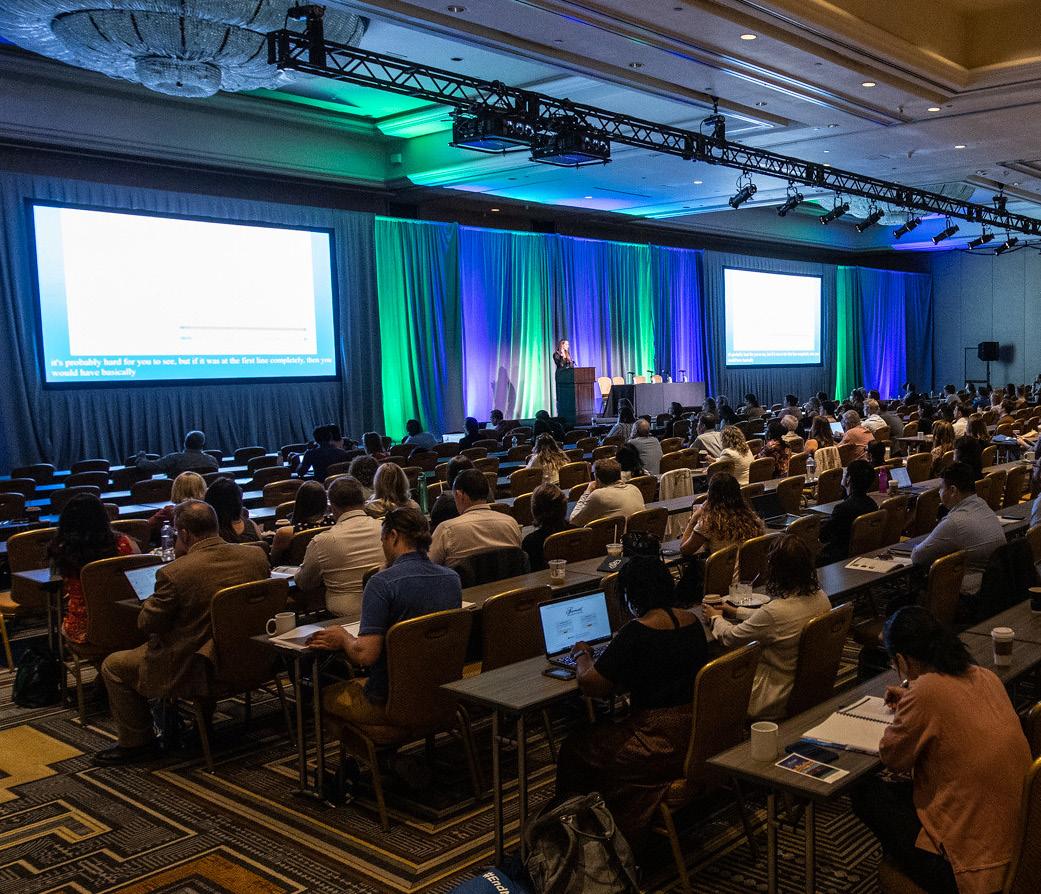
iPSCs surely could be applied to NF research and bring new light to faster and more translational drug screening. This very sophisticated method can be used to create more realistic (3D) tissue structures and is key for bridging the gap between traditional 2D cell models and living tissues.
With a main focus on improving the predictive impact of pre-clinical studies on clinical trials, reproducibility of findings becomes extremely important. CTF NF2 gene therapy grantee Lars Björn Riecken, PhD, from the Leibniz Institute on Aging, presented a new framework in preclinical research using a multi-center, confirmatorystudy approach following human clinical trial standards. Using this approach, the team showed some interesting data with protein replacement therapy for the treatment
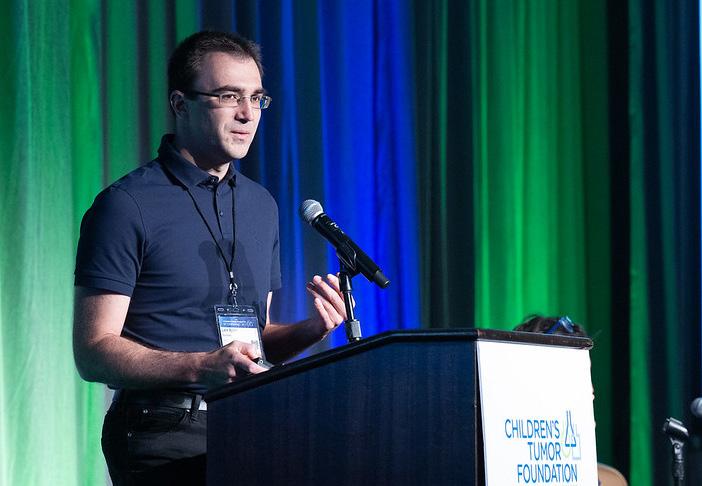

The 2023 NF Conference featured many original research projects that studied the experiences of individuals with NF, such as a patient’s quality of life and preferences for treatment. Studies like these help experts understand all the many ways NF impacts a person’s everyday living and enhance the visibility of NF experiences in research. This knowledge is an important step in the development of treatments that target the symptoms that are most important to patients.
One study by Katya Vera’s team at Stanford University compiled a large database of cutaneous neurofibromas (cNF) images from adults with NF1 and asked questions about symptoms, emotions, and daily functioning. The study sheds light on how specifically quality-of-life is impacted by the number and type of cNFs. These findings have the potential to provide “insight into which individuals and cNF tumors may benefit most from therapies.”
Prior CTF grantee Pam Wolters, PhD, and her colleagues at the National Cancer Institute presented a study that interviewed children and adults with plexiform neurofibromas (pNF) about tumor pain. Their goal is to create a way to measure patient outcomes with a mobile app which, once developed, can be used to collect and monitor the experiences of clinical trial participants from the comfort of their own home.
Lastly, a study conducted by Wendy Erler, VP Global Head of Patient Experience, Patiet Advocacy, and Patient Insights at Alexion, AstraZeneca Rare Disease, collected stories and experiences from the siblings of children with rare conditions. The report, which was presented as a poster at the conference, looks into how rare diseases, including NF, impact a patient’s family.
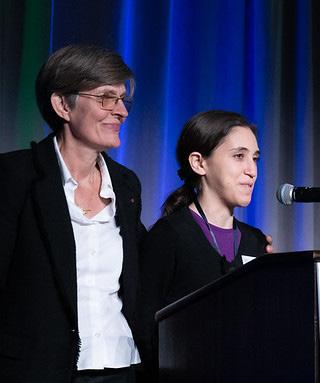
Together these studies capture perspectives that are often not found in traditional clinical research. This is important so researchers and government regulators, like the FDA, can understand how NF patients and their families feel about new and potential therapies. Sharing this knowledge with NF researchers is a key part of CTF’s aim to promote patient empowerment in research.
“This past June, I had a very unique opportunity— I attended the NF Conference as both a CTF employee and as an NF patient. I particularly enjoyed attending the combined NF Conference and NF Summit poster session when patients and families attending the NF Summit were invited to view the NF Conference posters, and speak with the NF researchers. It was neat to read about research being done that is very relevant to me and my future living with NF; I especially enjoyed the posters whose topics revolved around Quality of Life and other social/emotional NF issues. I enjoyed getting to speak with and ask questions to the poster presenters. We could speak in layman’s terms, and I could understand their findings. Since many of them are around my age, I didn’t feel intimidated as I might have if speaking to a high-level, older, more established doctor, like the invited speakers. I am so thankful that so many people around the world are dedicating their lives to doing research that will figure out how to end NF.”

Gene therapy is a way to correct a person’s abnormal gene to treat or cure a disease. The past decade has witnessed a revolution in gene therapy, with breakthrough discoveries, advanced innovations, FDA approvals, and the Nobel Prize and other recognitions. The field of NF research, which includes research into all types of neurofibromatosis and schwannomatosis, has also been marked by increased interest, and consequently new investment, in gene therapy-based research initiatives. Recognizing the possible applications of gene therapy in NF and responding to the NF community’s call for action, organizations like the Children’s Tumor Foundation (CTF), Gilbert Family Foundation (GFF), Neurofibromatosis Therapeutic Acceleration Program (NTAP), NF2 BioSolutions, and others launched several programs to investigate gene therapy as a potential therapeutic approach for NF. While recent successes in this rapidly advancing field hold great promise for NF, its relative nascency and the complexity of NF biology can present many obstacles in the path to success.
The 2023 NF Conference included a dedicated session on gene therapy with the objective of presenting the progress of current research and highlighting how developments in other diseases could apply to NF. The session also discussed challenges and limitations and addressed any ‘hype’ in developing a gene therapy for NF.

One of the gene therapy methods is gene replacement or delivering a functioning healthy gene to cells by packaging the gene in non-diseasing-causing virus vehicles or ‘vectors.’ The adeno-associated virus (AAV) is a commonly used vector and AAV-mediated gene therapy has been approved for several diseases. AAV’s applicability as a vector is, however, limited because the size of the genetic material that can be packaged in it is relatively small. The NF1 gene is one of the largest genes in the human genome, and as such, its gene size far exceeds AAV’s packaging capacity. Ivana Trapani, PhD, from the Telethon Institute of Genetics and Medicine, Italy, presented strategies to
overcome AAV’s limited cargo capacity and use them to deliver larger genes. The dual-AAV approach involves splitting a large gene into two halves and packaging each half into one of two separate AAV vectors. When cells are co-infected with both vectors, the gene fragments are released into the cell and undergo processing to assemble the full-length gene. In a different approach called protein trans-splicing, each of the two vectors produces one-half of the necessary protein, and the two protein fragments subsequently come together to reassemble the full-length protein. Dr. Trapani demonstrated the success of these approaches in an inherited retinal disease called Stargardt disease and highlighted their limitations. One important limitation is that in comparison to a single AAV approach, methods using two vectors may not produce adequate levels of protein for a meaningful clinical effect. This is especially important to consider in NF1 where it is not known how much neurofibromin, the protein produced by NF1 gene, is needed to reverse the effects of the disease.
While the large size of NF1 gene prevents packaging all of it into AAV vectors, a minimal gene fragment or “minigene” essential for normal activity can hypothetically be used in its place. Renyuan Bai, PhD, from Johns Hopkins University demonstrated the feasibility of such an approach by engineering a “miniNF1” gene consisting of DNA coding only for the GTPase-activating protein-related domain (GRD) of neurofibromin. The GRD is essential for suppressing the activity of Ras protein, which in turn prevents tumor development. The miniNF1 gene efficiently suppressed Ras activity in NF1 cells and when packaged into an AAV
vector that was developed to specifically target NF1 tumors, significantly suppressed tumor growth in a mouse model.
To date, over 2,000 pathogenic variants have been reported for NF1. Developing gene therapies tailored for each of them is almost impossible. Gene replacement and mini-gene approaches can be very versatile since these strategies are variant-agnostic and can mitigate the effects of a broad array of NF1 variants, benefitting a large number of patients. The existing NF1 animal models, in most of which the entire NF1 gene is inactivated, are adequate for studies involving these approaches. However, these animal models are not enough when studying specific gene variants or evaluating methods such as nonsense suppression and exon skipping that are applicable only to specific variant types. Robert Kesterson, PhD from Pennington Biomedical Research Center created several novel animal models harboring variants found in NF1 patients. Such patient-specific animal models would not only help investigate the manifestations of each variant but also develop and test new therapies exclusively targeting the causative variant. Dr. Kesterson also alluded to nanoparticles as novel delivery tools for gene therapy.

The NF1 gene is made of at least 57 exons or proteincoding sections interspersed by non-coding regions called introns. During the process of protein production, introns are removed, leaving only the exons. Exon skipping is a technique in which an exon is bypassed or “skipped” by masking it with small pieces of synthetic DNA called antisense oligonucleotides (ASOs). By skipping an exon carrying a pathogenic NF1 variant, it is possible to produce a functional, though shorter, neurofibromin, which can restore some levels of normal cellular function. Dr. Marc Moore from Teesside University, UK tested ASOs targeting exon 17 in an NF1 mouse model and observed exon skipping and neurofibromin production. While the technique needs to be further developed for NF1, in principle, exon skipping could be a therapy for this disease. One limitation is that only exons in non-critical regions of the gene can be skipped to maintain some gene function. Also, since the ASO is specific to a given exon, its applicability is limited to only patients with pathogenic variants within that exon. ASO-mediated
exon skipping has already been approved by the FDA for diseases such as spinal muscular atrophy (SMA) and Duchenne muscular dystrophy (DMD) and holds promise for many NF patients. Linda Popplewell, PhD, also from Teesside University, talked about the different therapeutic approaches developed for DMD, including ASO-mediated exon skipping and microdystrophin gene therapy using AAV vectors, and indicated that efforts are ongoing in her research to translate these approaches to NF1.
Peter Marinkovich, MD, from Stanford University presented his landmark study on developing a gene therapy for dystrophic epidermolysis bullosa (DEB), a skin disease that causes large painful open wounds. DEB results from mutations in the COL7A1 gene, which codes for type VII collagen (COL7), essential for strengthening and stabilizing the skin layers. Using the herpes simplex virus (HSV) vector, Dr. Marinkovich developed a topical gene therapy, applied as a gel directly to the wounds, that delivers the normal COL7A1 gene to the application site. The FDA recently approved this gene therapy for DEB. This study is relevant for NF1 because one of the manifestations of NF1 is cutaneous neurofibromas (cNF), which are tumors in or underneath the skin that can grow into large disfiguring bumps, often accompanied with pain and itching. There are currently no treatments for cNF. Virus-mediated gene therapy, similar to DEB’s, could be a potential option for cNF.
As part of NF2 Therapeutics (a company CTF has invested in since 2015), Jérémie Vitte, PhD, from the University of California, Los Angeles, presented data on AAV-NF2 in a mouse model. This was followed by a CTF-funded large animal (nonhuman-primate) safety study.. NF2 gene is relatively small and can be more easily delivered using viral vectors. Preliminary results showed that an AAV vector carrying the NF2 gene holds promise to be investigated for further development NF2-SWN.
Gene therapy is evidently a very powerful therapeutic strategy as it attempts to directly modulate the causative gene. While the advancements in this field are encouraging, an attitude of cautious optimism is necessary for NF, as there is still much to be discovered in this promising area.
Over the past decade, developments in the fields of genomics, molecular biology, and computational biology have led to more rapid discovery. This has expanded our understanding of how human health and disease function at the molecular, genetic, and cellular levels. For neurofibromatosis and schwannomatosis, finding the pathogenic variants involved (formerly referred to as genetic mutations) and a growing understanding of how these variants impact certain cells and pathways (the processes or molecular interactions within the cell) has been critical to identifying how to develop drugs that will effectively target the cells and pathways affected.

Since 1985, CTF’s annual NF Conference has brought together experts who focus on these questions 365 days of the year. In greater numbers than any prior year, attendees included non-NF scientists, physicians from a wide range of specialties, and industry partners. Over the four days of an agenda-filled conference, the energy was palpable. From early morning to late at night, attendees gathered to share ideas, communicate discoveries, and plan for collaboration and next steps to find treatments to end NF. Numerous clinical investigations and advancements were shared, and while it is impossible in this article to cover everything, some highlights are discussed below.
Methods for early detection and diagnosis are needed to ensure that patients receive treatment as soon as possible, which is extremely important for many diseases. This is particularly true in the case of malignant peripheral nerve sheath tumors (MPNST). Some plexiform neurofibromas (PN), for reasons we do not fully understand, can progress from benign (non-cancerous) plexiform neurofibromas (PN) to MPSNT (which are cancerous). Scientists
continue to investigate the mechanisms that cause this. MPNSTs are difficult to diagnose with the tools used today, such as MRI scans.
One area of great interest was presented by both Taylor Sundby, MD, from the National Cancer Institute (NCI), and Angela Hirbe, MD, PhD, from Washington University, both of whom are 2022 recipients of CTF research grants. Drs Sundy and Hirbe are working together to develop a blood test to detect, monitor, and tell doctors when to treat a PN before it becomes an MPNST. Using a test to detect circulating tumor markers in the blood, they can detect progression or relapse early, before the tumor grows. This is a game changer, as doctors will have a better noninvasive tool to detect, follow, and remove the PN before it becomes malignant and spreads. CTF is helping to fund this exciting project which will hopefully make an impact on patients who are at risk of developing MPNST.
However, for those not diagnosed early, researchers continue to look for better ways to treat MPNST. One exciting approach will look at how to use the patient’s own immune system to treat the tumor. Ping Chi, MD, PhD, of Memorial Sloan Kettering Cancer Center, and her colleagues are developing ways to use the patient’s own immune system to treat MPSNT. In her early research, she discovered that the area around the MPNST is what many call an immune desert. In other words, there are no immune cells found around the tumor. Since then, she has looked for ways to reactivate and attract immune cells to the tumor. Based on years of work, a new study is planned to look at introducing a vaccine together with checkpoint inhibitors that will attract immune cells to the tumor area and kill the tumor. A phase 1 trial of this study is planned.
It is also important to hear updates about current treatments being used for patients. Recipient of CTFfunding across several grant mechanisms, AeRang Kim, MD, PhD of the Children’s National Health System presented the results of a phase 2 study where two commercially available drugs are being given together, selumetinib (MEK inhibitor) with Sirolimus (MTOR
inhibitor), to see how these drugs when combined can treat patients with inoperable and rapidly growing MPSNT.
Thomas Wilson, MD, of Stamford University, presented his work studying a way to visualize pain on a PET/MRI scan using a radiolabeled marker that binds to and lights up painful areas, and does not light up in areas that are not painful. He showed encouraging early results and will continue to study this in NF patients. This will help surgeons and doctors identify the painful sites and target treatment to the areas of pain.
Another exciting development was presented by Larry Sherman, PhD, of Oregon Health & Science University, who is a longtime recipient of funding from CTF across number numerous award mechanisms. Dr. Sherman showed that SWN patients with the SMARCB1 pathogenic variant are more sensitive to pain due to increased cytokine release (IL6), a condition that develops when the immune system responds aggressively to infection. A trial is opening to study if blocking IL-6 with an antibody will relieve pain in patients with SWN.

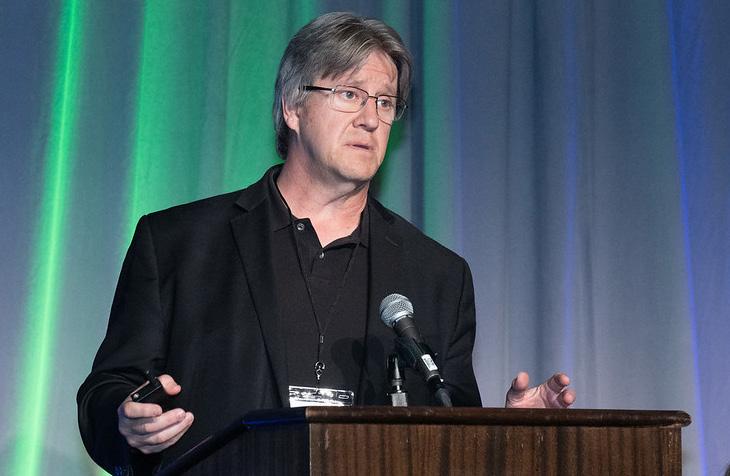
Additional important developments in clinical studies are being run in collaboration with CTF’s industry partners.

Earlier research has shown that the Hippo Yap TEAD pathway is one of the many pathways impacted in a cell by the loss of NF2 and the Merlin protein This leads to the development and progression of schwannoma and meningioma tumors. Therefore, developing drugs that turn off this pathway is an exciting approach to treat NF2-SWN tumors. Preclinical work facilitated by CTF has demonstrated that a drug being developed by Vivace Therapeutics, “VT3989” which shuts down this pathway, can reduce growth on the dorsal root ganglion in vestibular and non-vestibular schwannomas and can reduce the growth of meningiomas. VT3989 is currently in a phase 1 trial and shows activity in patients being treated for meningioma. The company is working to understand safe dosing.
On another front, Novadip Biosciences has developed bone grafts to treat NF1 patients who develop pseudarthrosis of the tibia. They have developed a stem cell therapy using a patient’s own fat stem cells, which are grown in the lab into bone stem cells. They are then grafted into the patient’s leg around the break with the intent that the bone stem cells will grow into bone. They presented some promising early results from two NF1 pediatric patients treated. A phase 1 trial in pediatric patients is open in Belgium and in Baltimore, Maryland.
Larry Sherman, PhDAnother highlight, Scott Plotkin, MD, PhD, of Massachusetts General Hospital, presented the results of brigatanib, a treatment for NF2-SWN patients who present with progressive tumors. While analysis is ongoing, brigatinib did show activity in NF2-SWN meningioma and non-vestibular schwannoma. This is the first drug being studied in the INTUITT clinical trial, a multisite adaptive platform basket trial being implemented in the USA. Brigatinib was selected because it showed promise as a result of CTF’s groundbreaking Synodos for NF2 research collaboration. Dr. Plotkin reported that the brigatinib treatment arm of the trial was fully enrolled, and it produced preliminary data for interim analysis in 36 months. This accelerated timeline is not seen in a traditional one-drug, one-tumor-type study. The CTF co-funded INTUITT trial is now enrolling patients to be treated with its second drug, and more drugs are being identified to be studied in this trial.
The neurofibromatosis clinical trials consortium, NFCTC, which develops biologically based therapies and implements clinical trials for children and adults with all types of neurofibromatosis and schwannomatosis, includes 24 sites across the USA and 2 in Australia. It has continued to expand since its conception in 2007 and will invite two new sites to join this fall. The consortium to date has completed 11clinical trials, 7 of which are open (enrolling or having data analyzed), and 7 trials are being planned across the NF2-SWN, plexiform neurofibroma, low-grade glioma, MPNST, neurocognitive, and bone disease committees.
An exciting update from the NFCTC is collaboration with European colleagues on study design and data platforms. This supports an important goal of CTF, which is to facilitate the opening of additional platform basket trials, similar to the INTUITT trial but on a
larger scale, in NF1 and SWN, including NF2-SWN. The first of these trials is a soon-to-be-open platform basket trial for NF1 in Europe called EU-PEARL, which the Children’s Tumor Foundation helped to develop in partnership with the Innovative Medicines Initiative (IMI). Once it proves feasible, the plan is to expand into a global initiative with the NF Clinic Network (NFCN) and expand on the INTUITT platform for NF2-SWN, which CTF is co-funding.
The neurofibromatosis therapeutic acceleration program (NTAP), whose mission is to focus on therapeutics in plexiform neurofibromas (PN) and cutaneous neurofibromas (CN), presented the work they are doing. There are currently 6 observational and therapeutic trials in CNs and 3 observational and therapeutic studies in PNs. The challenges to studying CN include incomplete natural history, a reliable and reproducible method to count lesions, and there are no clearly defined endpoints. Therefore, it is important to better understand the natural history of CN before effective treatments can be developed. NTAP is currently running an observational study and genome analysis for patients with CN. In addition, with several device-based therapies available for patients today, NTAP is studying the tolerability of these device-based therapies for patients with CN. This study is ongoing with two therapies tested, the Alesandrite laser and deoxycholic acid injection advancing to phase 2. Other studies being implemented by NTAP that are investigating different treatments for CN include a study of high-frequency ultrasound, systemic treatment with mirdametinib (sponsored by SpringWorks) currently open in Phase 1-2, and a study investigating gene replacement in CN.
This summarizes some of the highlights of clinical advancement presented at the 2023 Children’s Tumor Foundation NF Conference. As the meeting adjourned, it was clear that these initiatives and more would continue as new collaborations were forged and the clinical community returned home with innovative ideas and a better understanding of how to treat NF.

Poster sessions are an opportunity for researchers to showcase their work in Basic and Clinical Sciences to an audience of NF researchers. A panel of judges selects the top posters, and these investigators are invited to present their work in front of the full conference.

Below are the top posters at the 2023 NF Conference in Basic and Clinical Sciences.
1st place - Nipunika Somatilaka*
STING Inflames NF1 Malignancies for Immunotherapy
This is a novel therapeutic modality for MPNST. For immune checkpoint blockers (ICB) to work, T-cells and other immune cells must be near or within the tumor. MPNSTs are not rich in T-cells. Activating the STING-IFN pathway with STING agonists stimulates antitumor immunity via increased T-cell infiltration into the tumor microenvironment, making it susceptible to targeting with ICB.
2nd place - Lars Björn Riecken
Neuregulin 1 Beta Protein Replacement Therapy for the Treatment of NF2-associated Schwannomas – Insights from a Multicenter Preclinical Confirmatory Drug Trial Protein replacement therapy by injecting soluble recombinant neuregulin 1 reduces schwannoma formation and improves nerve regeneration, offering therapeutic promise for NF2-SWN. This poster presented the design of a preclinical trial following the standards of a human clinical trial. Results will enable expediting the translation of the design for a bigger trial.
3rd place - Namrata Raut*
Schwann Cell Calcium and Growth Factor Signaling Modulates Pain in NF1
This was the only poster investigating the mechanism of NF1 pain. Antibodies targeting the GDNF factor reduced hypersensitivity in NF1 mice.
1st place - Olivia Reid
Treatment of Cutaneous Neurofibromas (cNF) in Neurofibromatosis Type 1 (NF1) with the MEK Inhibitor Selumetinib
A trial investigating the effectiveness of oral selumetinib daily in 11 NF1 patients with cNF. Further exploration of a larger, more diverse population would be needed to better determine benefit risk in this treatment approach.
The Long and Short of it—Expanding the Phenotype of NF1 Microdeletion Syndrome
Individuals with microdeletions are reported to have a more severe clinical phenotype with larger tumor burden, malignancy risk, and learning difficulties. This study was developed in order to retrospectively characterize a large, diverse cohort of individuals with NF1 microdeletion for additional associations and outcomes. Reviewing charts of 44 patients with NF1 microdeletions over 30 years, they were able to conclude that there was a more favorable neurocognitive outcome in adults than typically reported in the literature. There was no increased occurrence of OPG compared to other known NF1-related tumors in this population.
Harmonization Across Imaging Locations (HAIL): Implications of Image Harmonization for NF1-OPG Clinical Trials
The team presented a deep-learning algorithm they developed to harmonize MRI data and enable accurate and reproducible data analysis across multiple clinical sites.
*Recipients of 2022 Young Investigator Awards from the Children’s Tumor Foundation





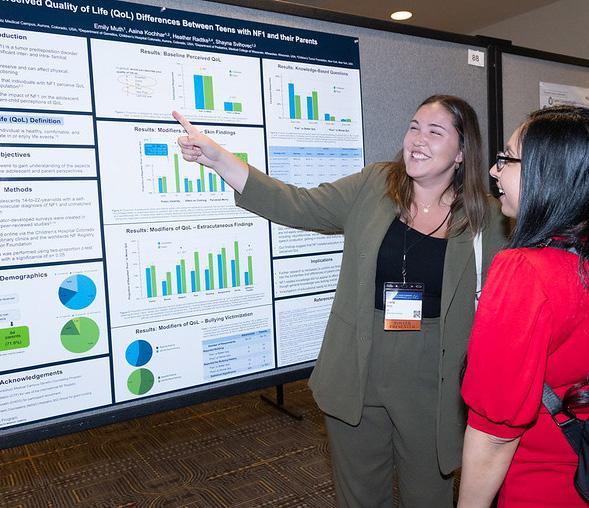


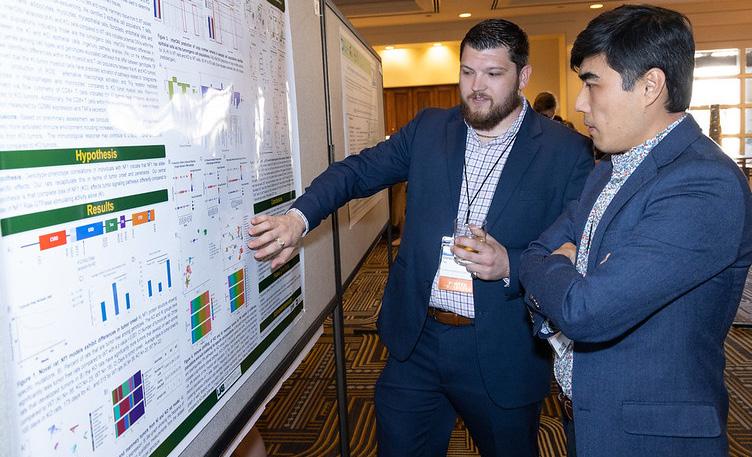
The Children’s Tumor Foundation’s Friedrich von Recklinghausen Award is given to individuals in the professional neurofibromatosis community who have made significant contributions to neurofibromatosis and schwannomatosis research or clinical care. It is named after Friedrich Daniel von Recklinghausen (1833-1910), the German physician who first described ‘von Recklinghausen’s disease’, what we now know as neurofibromatosis type 1 (NF1).
The Children’s Tumor Foundation announced the recipient of the 2023 Friedrich von Recklinghausen Award, Margaret Wallace, PhD, at the 2023 NF Conference. Dr. Margaret Wallace (aka Peggy) is a cornerstone NF field researcher. While she was a postdoctoral Young Investigators Award (YIA) fellow in the lab of Dr. Francis Collins at the University of Michigan, she played a vital role in cloning the NF1 gene in 1990. After her YIA fellowship from the Children’s Tumor Foundation, Peggy established her molecular genetics lab at the University of Florida’s College of Medicine and has since focused on finding and characterizing gene variants/mechanisms that contribute to NF manifestations through approaches of molecular genetics/genomics, cell biology, and animal models.


Peggy has numerous groundbreaking research papers and is the prime example of teamwork and open sharing. She created the first openly available NF immortalized cell lines that shipped these valuable research tools to researchers worldwide. Together with Dr. Andrea McClatchey, she co-chaired CTF’s highly successful Young Investigator Award program for over 15 years, which has funded nearly 200 young researchers, leading to a wealth of new insights, hundreds of publications, follow-up funding for NF from other agencies, new researchers in the field, preclinical studies, and clinical trials. Since 2018, Peggy also led a group of world-class experts in NF1 gene therapy that focuses on gene delivery and gene editing.
The Children’s Tumor Foundation, along with her colleagues and peers, is proud and thrilled to recognize Dr. Wallace with the 2023 Friedrich von Recklinghausen Award, not only for her many outstanding achievements over her years in the field but also for her dedicated efforts in supporting the entire NF community. Please join us in congratulating Dr. Wallace for this well-deserved honor.


CTF Engage is the Foundation’s Patient Engagement initiative, designed to prepare individuals with NF and their families to add their perspective during all phases of the research process – from the laboratory, to the clinic, to the community.
Patient Representatives team up with researchers and other drug development stakeholders as advisors, consultants, and co-investigators to help these experts understand what it is like to live with NF and what outcomes are important to patients.
Over the past several years, CTF has trained patients and their family members to become effective advocates in NF research. Moving forward, we are building upon this success and are looking to add new Patient Representatives to this program.
We are looking for NF-affected adults and NF care advocates of all backgrounds. Must be 18 or older to apply. There is no experience required.
To indicate your interest in becoming a Patient Representative, please scan the QR code or go to ctf.org/patientengagement to learn more.
If you have any questions, please direct them to Emily Greaves, egreaves@ctf.org.
